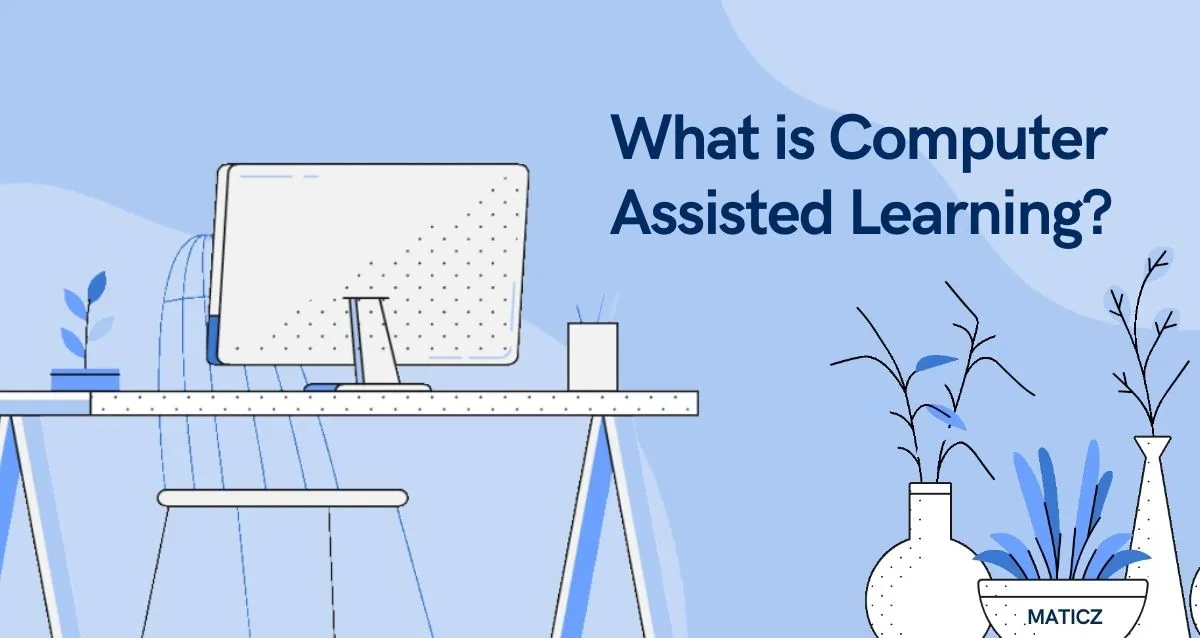Share Posts

What is Computer Assisted Learning?
53
4853
103
Technology is changing every industry with its development often in a better way. The inter-junction of education and learning is colloquially called EDtech. In the fast-paced world of innovation, education has moved to the next phase of improvement with the help of computer assistance by reshaping the learning landscape.
At present, it is hard to get off the smartphones and pay attention to something productive, fortunately, the same mechanism is used to incorporate the user’s time into the learning environment. As we explore the digital age, the combination of technology and education opens up the scope of odds and chances to the new platform of education.
Computer Assisted Learning Defined
In recent times, the fusion of technology and education has transformed the traditional way of learning. One such tool that earned notable heed is Computer-assisted learning. Though it has been around for decades, it's created a buzz by altering the educational trail in the last few years.
Computer-assisted learning (CAL) is described as the use of digital technology and electronic devices to enhance and support the process of education. It is a strategy followed to combine technology and education to optimize the learning process. They also assist the user in identifying the areas of development in every aspect.
Growth Of CAL
The history of Computer-assisted learning can be traced back to the 1960s, it was first introduced on the university mainframe computer which included a wide range of interactive games, quizzes, and educational materials. The affordable and accessible introduction of mainframe computers leads to the development of educational software for a wider audience.
In the 1980s and 1990s, the emergence of the internet and multimedia in educational software with the use of audio, video, and graphical elements become more popular in supporting the engaging and interaction growth of CAL.
During the mid-1990s the emergence of the internet transformed Computer Assisted Learning into an e-learning platform enabling synchronous learning. In addition to this, with the rise of smartphones and tablets in recent years, it has become more accessible and mobile enabling adaptive learning techniques which allow the user to access information from various devices.
With the latest technical advancements like VR and AI immersive learning experiences and adaptive learning, the system provides even more personalized and dynamic learning content. Throughout its evolution, it has developed along with the advancement in technology.
How Computer-Assisted Learning Evolved?
These years of history can be vaguely divided into three main categories where each category corresponds to a certain level of technology. They are:
Behavioristic CAL
This phase was started in the 1950s but was implemented in the 1960s and 1970s. They mainly used drill and practice methods where the system plays the role of the tutor who never gets tired of instructing the learner to work at an individual pace.
Communicative CAL
This phase became more popular during the 1970s and 1980s and also used a communicative approach where computers remained to the tutor. They used a non-drill format allowing more interaction with the learners.
Integrative CAL
This phase came into action with the introduction of 2 important innovations namely multimedia and the internet.
In the mid-1990s, multimedia CAL was nothing but reading, writing, speaking, and listening merged into a single activity where learners have a high degree of control over the path they follow through learning.
The early days of the Internet in the 1970s only impacted CAL with the arrival of the World Wide Web in 1993. The Web allows users to search millions of files within a few minutes. This is the phase where the CAL shifted from tutorial-based learning to a medium that provides an extended education.
Types Of Computer-Assisted Learning
Computer Assisted Learning comprises various types each one possessing specific educational needs and objectives. Let's discuss some of its types.
Tutorials
Computer Assisted Learning offers a comprehensive guide to diverse topics offering the learners a detailed description to reinforce their understanding. They use interactive tools to evaluate and provide immediate feedback thus resulting in a responsive learning experience.
Gamified Learning
CAL uses a gamified approach to engage the students to understand the concept through an interactive process. Learners would be promoted to the next level after explaining what they grasped from the certain content.
Practice
Computer Assisted Learning focuses on repetitive exercise employing a practice-oriented approach to understand the specific concept. By consistently following the exercise, make sure that learners achieve mastery of certain skills.
Demonstration
Demonstration CAL uses visuals and sounds to explain the concept to the learners thus making it easier for them to understand.
Simulation
The dynamic environment replicates the real-world scenario to help the learners apply the theoretical knowledge to the practical context. It helps to bridge a gap between the theory and application resulting in a better understanding of the complex concepts.
Computer-based Assessment
Computer-based assessment will replace the traditional pen-paper method with digital formats which include interactive elements and instant feedback.
Intelligent Tutorial System
Computer Assisted Learning employs artificial intelligence to provide personalized tutoring. They adapt to the individual needs and build the educational content according to the specific requirements of the individual. They support targeted guidance.
Virtual Lab
With the help of CAL, they recreate the physical lab conditions to enable the learner to conduct the scientific experiment in the virtual. They enhance the practical understanding of the concept in the safe platform.
Adaptive Learning System
Computer Assisted Learning provides a personalized approach to the learner's education by adjusting to their pace and learning progress. They use data-driven insights to build the learning experience according to the learner's strengths weaknesses and preferences.
AR And VR
The integration of AR and VR results in immersive learning experiences transferring the learners to the three-dimensional environment. This enhances the understanding of the subject by providing interactive educational content.
Features Of Computer-Assisted Learning
Computer Assisted Learning consists of various key characteristics that define the impact on education. Now let's discuss some functionalities that help CAL make a distinctive learning approach.
Integration
Computer-assisted learning helps in the integration of devices and technology to help learners change the way they access education.
Multimedia Fusion
CAL Helps in the fusion of various multimedia elements like audio, video, graphics, and other interactive simulations, to enhance the educational content comprehensively.
Endless Practise
Computer Assisted Learning helps the learners understand the concept by providing continuous practice through challenges, quizzes, and assessments. They never get tired of providing practice which stimulates the curiosity of the learner.
Creative Content
They can create creative content for the user to gain knowledge about particular topics.
Grasping
Computer Assisted Learning breaks down complex concepts into small portions to easily understand the particular concepts before moving to the next one. It is done so to help the earner to sense the progress of the syllabus.
Translation
It is used in translation tools thus helping people to overcome the language barrier.
Benefits Of Computer-Assisted Learning
Some advantages highlight the positive aspects of CAL and enhance education experiences. Let's see some of the benefits below.
Learning Accessibility
Computer Assisted Learning can make education accessible to a larger audience by allowing learners with diverse needs to access the learning material in various formats.
Instant Feedback
Immediate feedback is the key feature of the CAL. This instant feedback mechanism allows the learner to address the area of improvement soon after the assessment is done. It helps them to identify and correct the mistake promptly also resulting in the iterative and efficient learning process.
Collaborative Tutor
Computer Assisted Learning facilitates the collaborative learning experience among students through online discussions, forums, and virtual discussions. This helps the learners to gain a better understanding of the complex concepts.
Data Analysis
This system collects the learner's performance and engagement among the other learners. The collected data is analyzed to receive insights into the individual learning skills that help the tutor design the instruction according to the learner's skills.
Adaptability
They are designed to adapt to the learner's progress and performance. They will adjust according to the learner's specific needs and skill level of requirement
Individualized Learning
Computer-assisted learning allows the learner to progress at their own learning pace enabling self-directed learning. This flexibility fits in with different learning paces helping the learner to focus on the strengths and address the weaknesses.
Interactive Environment
This feature incorporates interactive elements like a quiz, simulations, and other presentations to enhance engagement and allow deeper understanding.
Flexibility
Internet connection is the only necessity to access the Computer Assisted Learning from anywhere and anytime. This feature is an advantage to learners with varied learning preferences and schedules.
Cost-Effective
On a long-term basis, it can cut the costs in need for physical resources like textbooks and study materials and also allow the reusability of digital materials. It also reduces the cost of setting up the traditional classroom.
Rapid Update
Here CAL allows the real-time update of the digital material available to the users so that it ensures that learners are provided with the current information.
Industries That CAL Support
Let’s Discuss some industries where Computer Assisted Learning is utilized
Education: Computer-assisted learning facilitates the individual learning experience enabling the system to design the personalized learning material according to the requirements and pace. It also helps to focus on the areas where they need improvement. Another added advantage is flexibility which allows the user from a remote area to overcome physical barriers. It also provides a continuous learning opportunity to get updated in relevant fields.
Corporate Workplace: Many organizations use online training courses for trainees which helps them to understand the job motives. Also supports the employees to stay updated in the current trend.
Medicine: CAL is used in medical industries allowing a professional to develop their skills like surgeries, and anatomies in a safe and controlled environment. Additionally, it helps the patients to understand their medical conditions and manage their health.
Entertainment: They provide interactive and immersive gaming experiences to users in AR and VR, by taking them to a whole new virtual space with a dynamic environment
Research and Innovation: Computer Assisted Learning assists the resources in data collection and analyzing a large volume of data efficiently.
Finance: It is implemented to improve the knowledge about the finance concept and help the user to make a wise decision in budgeting and investing.
Conclusion
CAL has emerged as a powerful tool in improving our daily lives by offering various benefits in terms of educational and professional development. The versatility of computer-assisted learning is a prominent feature in the building of personalized learning lessons for an individual according to their respective skill. As we look into the future, the continued innovation in ed-tech will reshape the landscape of learning. Overall Computer Assisted Learning is an integral part of our daily lives in shaping how we learn, work, and engage with information.
Tap Into the Future
The latest insights, posts, and project updates - straight to your inbox.




